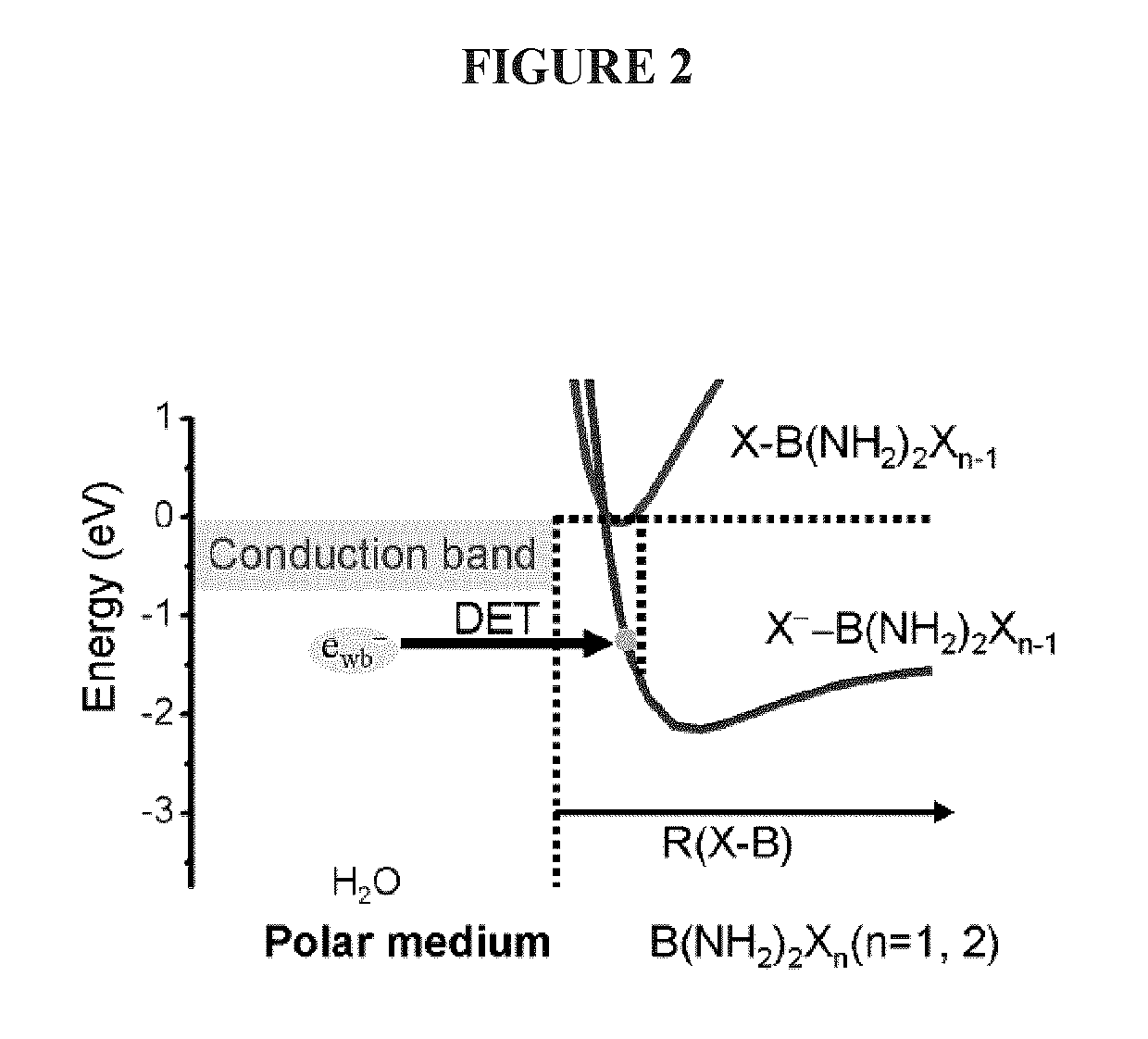Non-platinum-based anti-cancer compounds for use in targeted chemotherapy
a technology of non-platinum-based anti-cancer compounds and chemotherapy, which is applied in the direction of heterocyclic compound active ingredients, drug compositions, immunological disorders, etc., can solve the problems of severe nausea and vomiting, kidney toxicity, liver toxicity, and side effects of chemotherapy
- Summary
- Abstract
- Description
- Claims
- Application Information
AI Technical Summary
Benefits of technology
Problems solved by technology
Method used
Image
Examples
example 1
nd Laser Spectroscopic Observation of the DET Reaction of Anti-Cancer Compounds (NPBS) with a Weakly-Bound Electron
1.1 fs-TRLS Method
[0233]Femtosecond (fs) time-resolved laser spectroscopy (fs-TRLS) is the most versatile and powerful technique for real-time observation of molecular reactions. It uses laser flashes of such short duration that we are down to the time scale on which the reactions actually happen—femtoseconds (fs) (1 fs=10−15 seconds). The DET reaction of a new NPB anti-cancer compound with a weakly-bound electron was studied by the fs-TRLS methodology, which was demonstrated previously [Lu, 2007; 2010]. For the latter, briefly our fs laser amplifier system (Spectra-Physics, Spitfire) produced laser pulses with a pulse width of 100-120 fs at a repetition rate of 500 Hz. A intense pump pulse at 350 nm was used to generate a weakly-bound electron (ewb−) by 2-photon excitation of a H2O molecule into a higher energy state H2O* that then ionizes to produce an ewb−; a probe p...
example 2
Tests on the Toxicity of NPBs in Treating Human Normal Cells
2.1 Materials & Methods
[0236]2.1.1 Chemicals and Reagents
[0237]Cisplatin, dichloro-diamino-benzene (Compound A), bromo-diamino-benzene (Compound D), insulin, and 3-(4,5-Dimethylthiazol-2-yl)-2,5-diphenyltetrazolium bromide (MTT) were obtained from Sigma-Aldrich. Dibromo-diamino-benzene (Dibromo-phenylenediamine, Compound B) was obtained from TCI-America. Diiodo-diaminobenzene (Compound C) was synthesized, purified and crystalized in our laboratory, and the structures and purity were examined by NMR and mass spectrometry. MEM and fetal bovine serum (FBS), penicillin G and streptomycin were obtained from Hyclone Laboratories (UT, USA). Stock solution of cisplatin was freshly prepared in ultrapure water or saline, and stock solutions of Compounds A, B, C, D were prepared in pure ethanol, where the final concentration of ethanol was ≤1% when treated to cells.
[0238]2.1.2 Cell Culture
[0239]A human skin diploid fibroblast (GM05757...
example 3
Anti-Cancer Results of NPBs in Treating Various Cancer Cells
3.1 Materials & Methods
[0244]3.1.1 Chemicals and Reagents
[0245]Cisplatin, dichloro-diamino-benzene (Compound A), bromo-diamino-benzene (Compound D), insulin, and 3-(4,5-Dimethylthiazol-2-yl)-2,5-diphenyltetrazolium bromide (MTT) were obtained from Sigma-Aldrich. Dibromo-diamino-benzene (Dibromo-phenylenediamine, Compound B) was obtained from TCI—America. Diiodo-diaminobenzene (Compound C) was synthesized, purified and crystalized in our laboratory, and the structures and purity were examined by NMR and mass spectrometry. MEM and fetal bovine serum (FBS), penicillin G and streptomycin were obtained from Hyclone Laboratories (UT, USA). Stock solution of cisplatin was freshly prepared in ultrapure water or saline, and stock solutions of Compounds A, B, C, D were prepared in pure ethanol, where the final concentration of ethanol was ≤1% when treated to cells.
[0246]3.1.2 Cell Culture
[0247]A human skin diploid fibroblast (GM05757...
PUM
| Property | Measurement | Unit |
|---|---|---|
| rise time | aaaaa | aaaaa |
| rise time | aaaaa | aaaaa |
| time | aaaaa | aaaaa |
Abstract
Description
Claims
Application Information
 Login to View More
Login to View More - R&D
- Intellectual Property
- Life Sciences
- Materials
- Tech Scout
- Unparalleled Data Quality
- Higher Quality Content
- 60% Fewer Hallucinations
Browse by: Latest US Patents, China's latest patents, Technical Efficacy Thesaurus, Application Domain, Technology Topic, Popular Technical Reports.
© 2025 PatSnap. All rights reserved.Legal|Privacy policy|Modern Slavery Act Transparency Statement|Sitemap|About US| Contact US: help@patsnap.com



